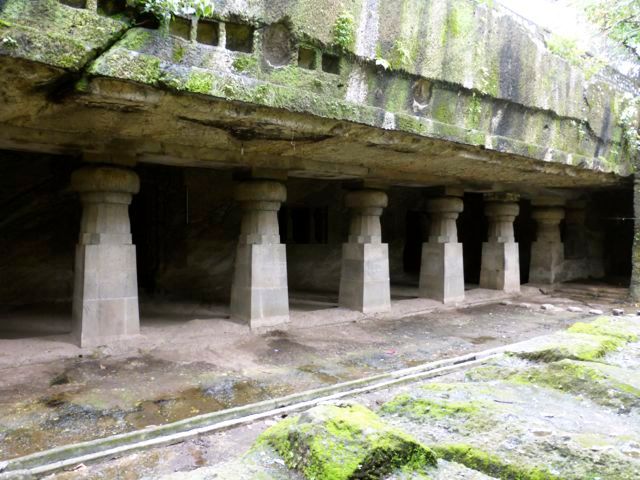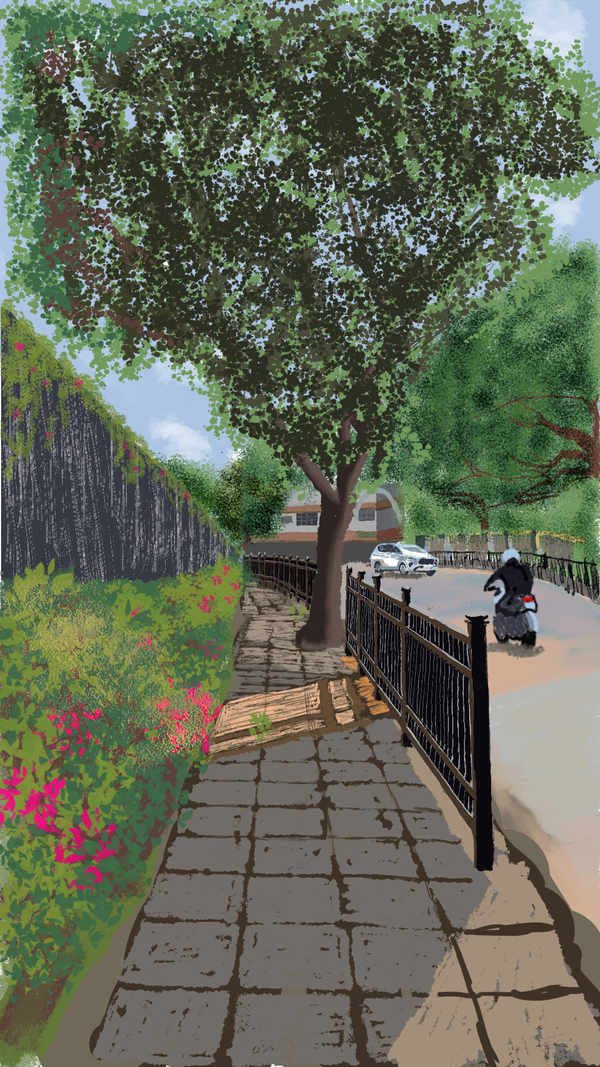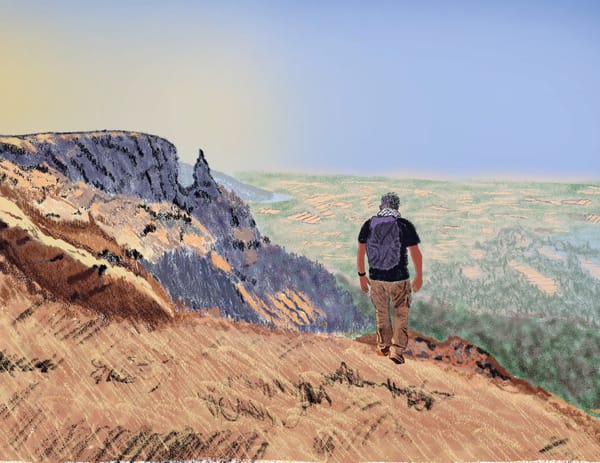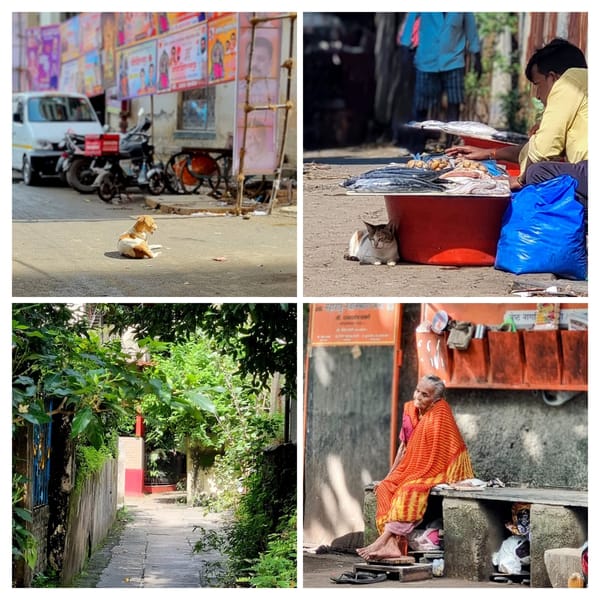Cycling to Jogeshwari Caves, Mumbai
In the heart of the city at the junction of the Western Express Highway and the Jogeshwari Vikhroli Link Road (JVLR), among the shanties of Prabhat Nagar lies an ancient and forgotten cave. This is one of the oldest known Hindu caves and the second largest cave after Kailas in Ellora. The access to the cave is from either JVLR or Western Express Highway, or the road from Jogeshwari Station that runs through a subway under the Western Express Highway.
In his article “The Slum and the Sacred Cave“, Samir Patel, executive editor of Archeology Magazine writes:
In the state of Maharashtra, of which Mumbai is the capital, there are around 1,200 rock-hewn temples, dug and carved by hammer, chisel, and sweat from the basalt of the Deccan Plateau and ranging in size from small shrines to massive temple complexes. The tradition began with Buddhist shrines in the first and second centuries b.c. These monuments reached their apex under the Buddhist Vakataka Dynasty in the fifth century a.d. with the caves at Ajanta, a group of 30 gloriously carved and painted shrines in a gorge more than 200 miles east of Mumbai. But it was not until the sixth century that Hindus in the region began to adopt the practice.“It is only at this stage, at this very, very late stage, that the Hindus start cutting their caves,” says Vidya Dehejia, a historian of Indian and South Asian art at Columbia University.“Why they didn’t do it earlier is just one of those mysteries.”
After the death of the Vakataka king Harisena, who was patron for much of Ajanta, feudal rivalries overwhelmed the dynasty and it is thought that many of the artisans from Ajanta sought greener pastures. Some may have traveled west to the Hindu Kalacuri kingdom and began the first great Hindu cave temples — first at Jogeshwari and then at Elephanta. As Shaivite Hindus, the Kalacuris worshiped Shiva as the supreme god, rather than as part of the traditional Hindu trinity of Brahma the creator, Vishnu the preserver, and Shiva the destroyer. Under the early Kalacuri Dynasty, shrines to Shiva quickly achieved the scale and artistry of their Buddhist predecessors. But the most impressive and fully realized of the Hindu caves, Elephanta, and a similar cave called the Dhumar Lena (one of 35 caves and temples spanning five centuries at the monumental complex at Ellora, near Ajanta), owe a debt to Jogeshwari. “In terms of Hindu cave temples, it’s the father or the grandfather of them all,”
After visiting Mahakali or Kondivite Caves and Kanheri Caves nearby, I was keen to visit Jogeshwari and Mandapeshwar caves. In spite of having a long weekend, it was a busy one – so a short cycle ride to Jogeshwari this weekend seemed like a perfect plan. I and my son Rohan cycled to the caves early on Friday morning. We did not know what to expect, but when we saw the enormous size of the cave, we wondered why it lies there forgotten by the citizens of Mumbai unlike the Elephanta or Ellora caves.
To really do justice to the cave, you need to understand its vast layout. The entire layout spans a length of 300 feet along the east west direction and 200 feet in breadth
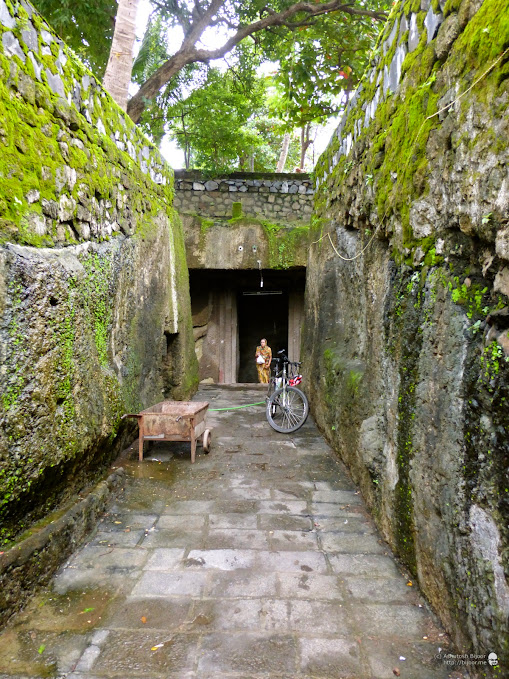 The caves are dug into the rocky hill, and one enters the cave through a narrow passage that leads into the cave
The caves are dug into the rocky hill, and one enters the cave through a narrow passage that leads into the cave
 A small opening at the end of the entrance passage has a water tank on the right and a small open space on the left, where we parked our cycles and locked them to each other
A small opening at the end of the entrance passage has a water tank on the right and a small open space on the left, where we parked our cycles and locked them to each other
 From the opening at the end of the passage, steps lead down to a doorway to the Entry Portico. The door frame has an exquisitely carved pattern all around it
From the opening at the end of the passage, steps lead down to a doorway to the Entry Portico. The door frame has an exquisitely carved pattern all around it

 The portico has another door on the back wall. On both sides of the inner door, there are giant figures carved on the wall. These carvings are also completely worn out probably due to the crumbling volcanic breccia rock that the cave is cut into and constant exposure to water seeping through the hill
The portico has another door on the back wall. On both sides of the inner door, there are giant figures carved on the wall. These carvings are also completely worn out probably due to the crumbling volcanic breccia rock that the cave is cut into and constant exposure to water seeping through the hill
 The inner door from the portico leads into the big main hall – a 90 feet square and about 10 feet high. About 15 feet away from the walls, there are pillars on all four sides. These pillars are very similar in design to the ones found in Elephanta Caves
The inner door from the portico leads into the big main hall – a 90 feet square and about 10 feet high. About 15 feet away from the walls, there are pillars on all four sides. These pillars are very similar in design to the ones found in Elephanta Caves
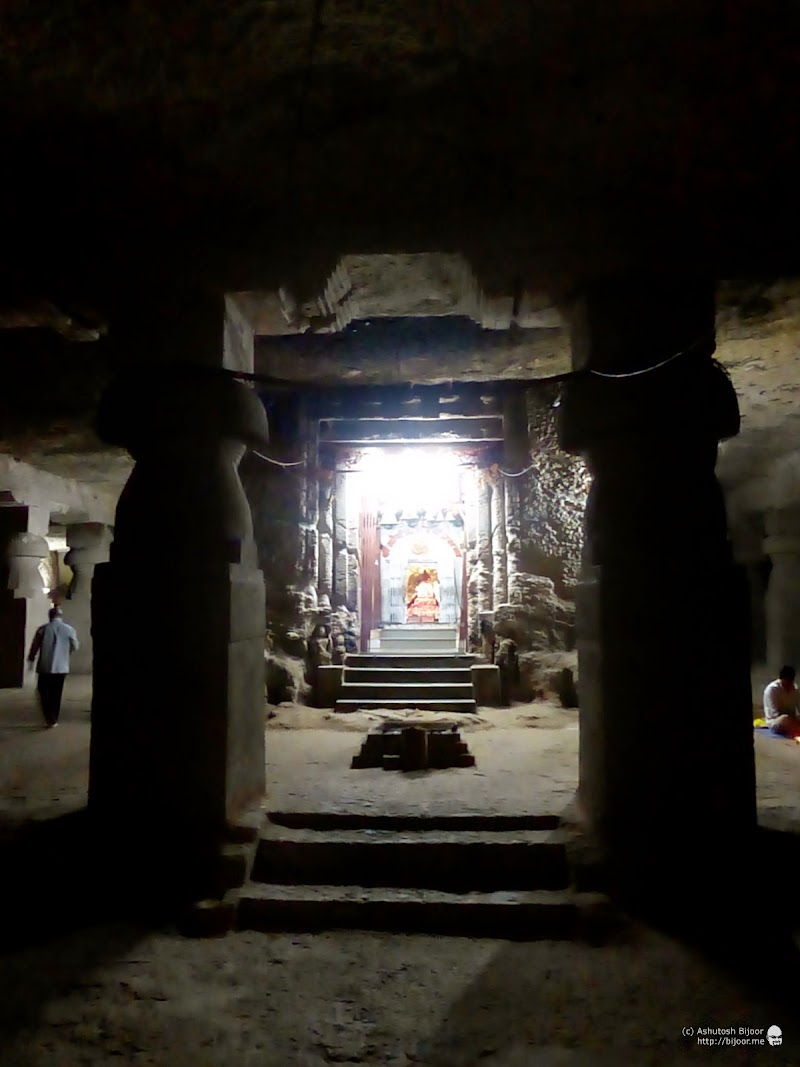 In the center of the main hall surrounded by pillars on all four sides, is a sanctum sanctorum with the idol of Jogeshwari Devi
In the center of the main hall surrounded by pillars on all four sides, is a sanctum sanctorum with the idol of Jogeshwari Devi
 This Godess is till today being worshipped by some communities as their “Kuladevi” or ancestral Godess
This Godess is till today being worshipped by some communities as their “Kuladevi” or ancestral Godess
On the end of the main chamber opposite to the entrance is another door that leads to the middle chamber that has the most number of carved friezes on the wall. The chamber has two cells on either side separated by a series of pillars.
Unfortunately there is a lot of water seepage here – especially in the monsoon. The carvings have been covered in some white material that could be plaster, and a large plastic sheet hangs in the middle of the chamber to protect visitors from the water dripping down from the roof. The carvings are quite exceptional because they actually stand out of the wall in 3 dimensions almost like they are free standing statues. The two large statues on either side of the door are of warders who guard the temple surrounded by images of gans or attendants of Shiva.
 There are three carved panels above the door. The left side panel depicts Shiva’s wedding
There are three carved panels above the door. The left side panel depicts Shiva’s wedding
The center panel is a seated Shiva worshipped by ascetics
The panel on the right is Shiva and Parvati. These panels are relatively in tact in spite of the water seepage
 At the back of the inner portico is another door that leads to an open courtyard. The outer side of the door has a carved pattern all around it, and a damaged image of Shiva doing the tandav dance above the door, and two carvings of dancers on either side
At the back of the inner portico is another door that leads to an open courtyard. The outer side of the door has a carved pattern all around it, and a damaged image of Shiva doing the tandav dance above the door, and two carvings of dancers on either side
The area is strewn around with large rocks, and the walls seem to have remnants of a rooflike cantilever that indicates that this area may also have been covered by a roof at one time that may have collapsed, or could have been unfinished
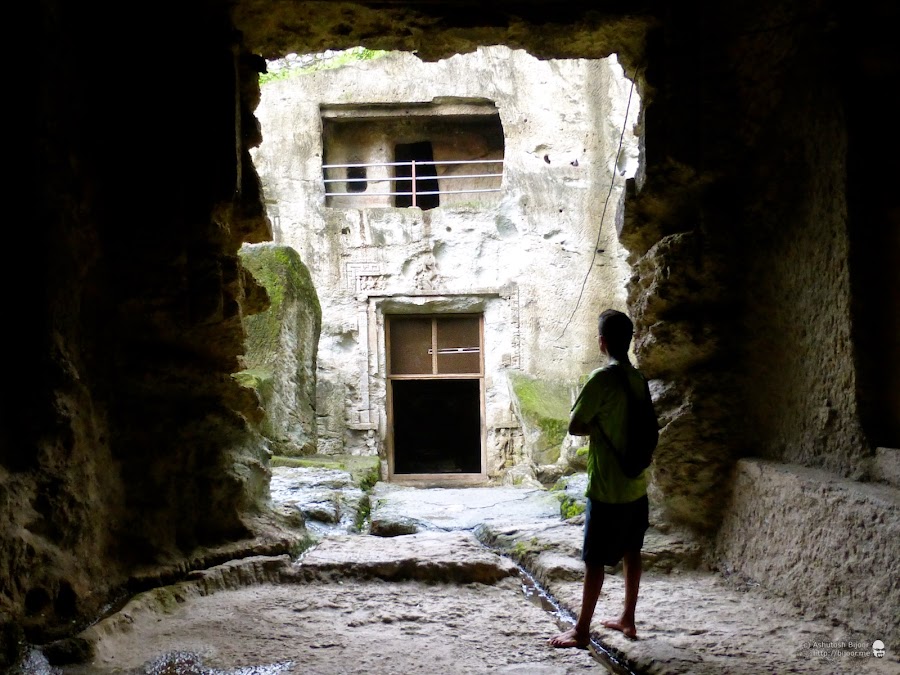 At the other end of the open courtyard opposite the inner portico, is another almost identical portico. From here one can clearly see the railings above the door of the inner portico. This is a cell that is accessible from the surface above the cave, and contains a temple to Lord Dattatreya
At the other end of the open courtyard opposite the inner portico, is another almost identical portico. From here one can clearly see the railings above the door of the inner portico. This is a cell that is accessible from the surface above the cave, and contains a temple to Lord Dattatreya
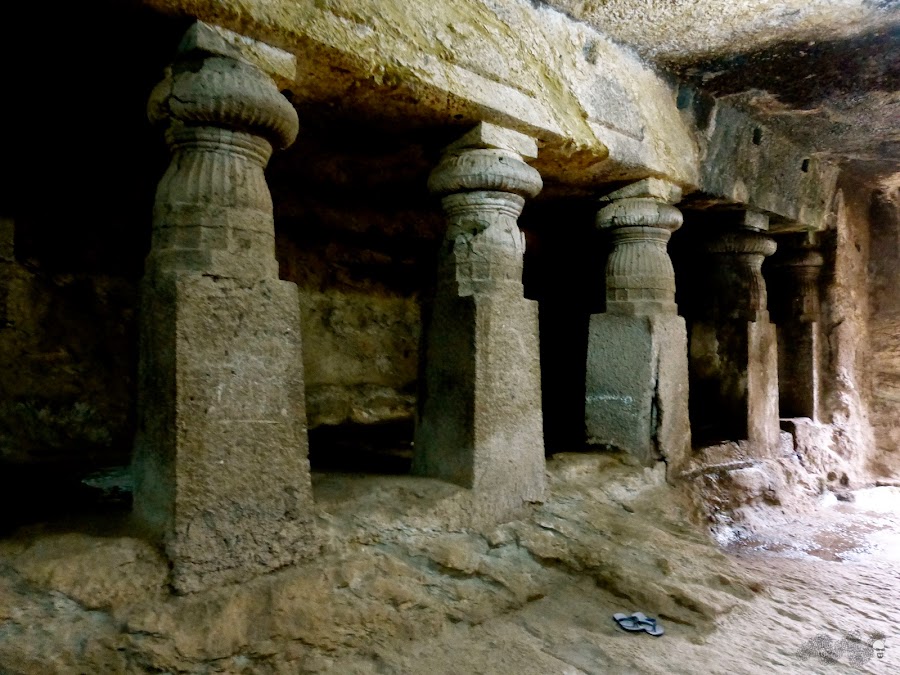 The outer portico also has two cells on either sides separated from the central area by a series of pillars
The outer portico also has two cells on either sides separated from the central area by a series of pillars
 In the right cell is a temple of Lord Ganapati
In the right cell is a temple of Lord Ganapati
 The bautiful Ganapati idol sitting on his vehicle of choice – the mouse – is also presumably carved out of the rock and is covered by the signature orange colored ‘sindhur’
The bautiful Ganapati idol sitting on his vehicle of choice – the mouse – is also presumably carved out of the rock and is covered by the signature orange colored ‘sindhur’
 Back in the open courtyard towards the south-west corner there is a tunnel that leads to a passage that branches into two – one going towards the Maruti temple on the left and another leading to the verandah on the right
Back in the open courtyard towards the south-west corner there is a tunnel that leads to a passage that branches into two – one going towards the Maruti temple on the left and another leading to the verandah on the right
 To the south of the main hall there are two doors on either ends that lead to a large pillared verandah
To the south of the main hall there are two doors on either ends that lead to a large pillared verandah
 Just outside the verandah there is another open courtyard surrounded by empty cave cells
Just outside the verandah there is another open courtyard surrounded by empty cave cells
 Around the doors leading to the verandah are remnants of carvings that have eroded beyond recognition
Around the doors leading to the verandah are remnants of carvings that have eroded beyond recognition
 There is also a window in the middle that looks into the main hall
There is also a window in the middle that looks into the main hall
 The open courtyard outside the verandah has some emtpy cave cells surrounding it
The open courtyard outside the verandah has some emtpy cave cells surrounding it
 These cells have a few carved figures on one side.
These cells have a few carved figures on one side.
Till a few years back, the place was highly neglected and was overrun by garbage thrown by the dwellers in settlements above the cave. However now the place is well taken care of by a private agency that is appointed by the ASI, and the place is devoid of any garbage or stench
 At the eastern end of the verandah and open courtyard outside, there is a small maze-like passage that leads to a Maruti (Hanuman) Temple
At the eastern end of the verandah and open courtyard outside, there is a small maze-like passage that leads to a Maruti (Hanuman) Temple
 There is one man who has been coming here daily and cleaning the shrine and lighting the lamp for more than 50 years
There is one man who has been coming here daily and cleaning the shrine and lighting the lamp for more than 50 years
 The diety of Lord Hanuman (also called Maruti) is placed on a platform and is regularly worshipped by people living in the surrounding area
The diety of Lord Hanuman (also called Maruti) is placed on a platform and is regularly worshipped by people living in the surrounding area

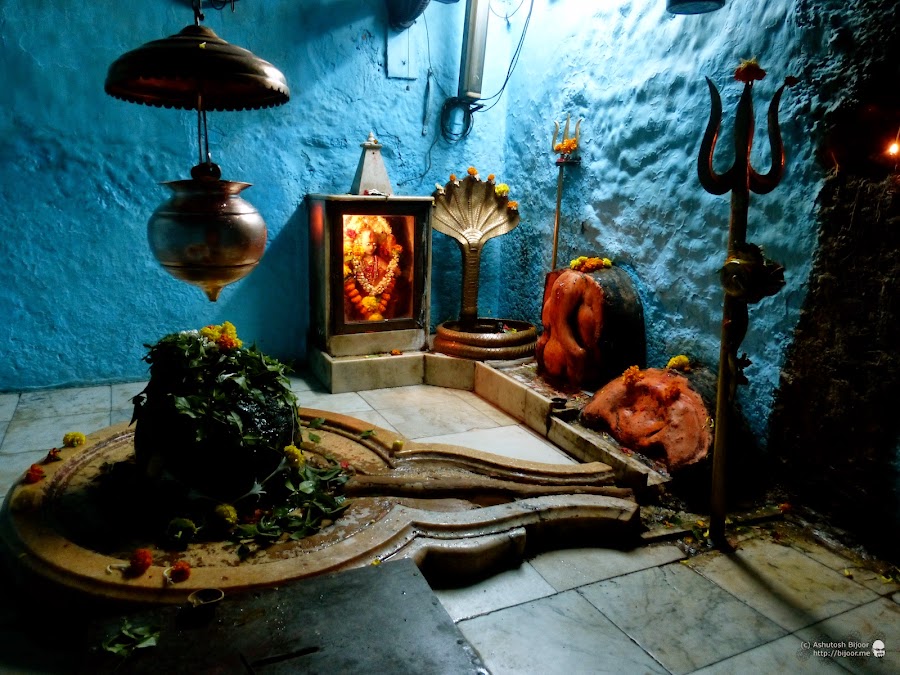 At the western end of the verandah there is a cell that contains a Shiva Linga with a Nandi statue outside – the typical model of a Shiva temple. The Nandi statue is made of marble, indicating that this temple could be a later addition to the caves.
At the western end of the verandah there is a cell that contains a Shiva Linga with a Nandi statue outside – the typical model of a Shiva temple. The Nandi statue is made of marble, indicating that this temple could be a later addition to the caves.
 The last place to visit is the Dattatreya Temple located above the inner portico, that is accessible from a path leading up above the cave from outside the entrance passage
The last place to visit is the Dattatreya Temple located above the inner portico, that is accessible from a path leading up above the cave from outside the entrance passage
 The idol of Lord Dattatreya is also smeared with orange Sindhur or more likely oil paint, and an oil lamp is lit in a cutout shelf beside it
The idol of Lord Dattatreya is also smeared with orange Sindhur or more likely oil paint, and an oil lamp is lit in a cutout shelf beside it
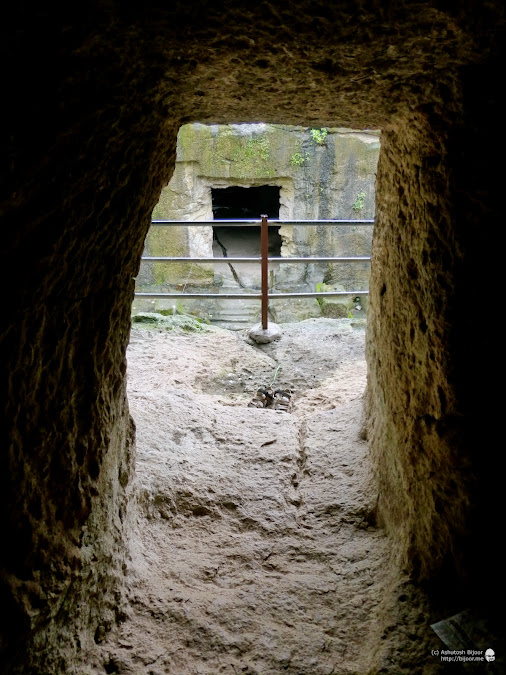 The railing outside looks over the open courtyard between the inner and outer portico to the east
The railing outside looks over the open courtyard between the inner and outer portico to the east
 Having explored all the different features of this impressive cave, we get our cycles and head back home, satisfied on finding a treasure that was much more impressive than we could have ever imagined… and ironically located so close to where we live!
Having explored all the different features of this impressive cave, we get our cycles and head back home, satisfied on finding a treasure that was much more impressive than we could have ever imagined… and ironically located so close to where we live!
Samir Patel concludes in his article:
Despite the wealth of deep, complex cultural heritage in India, sites such as Jogeshwari often do not matter for their own sake, but only for what they provide — tourist dollars, a place to pray during the day, a place to hide or drink at night. “It’s almost inevitable in a country in which resources are that limited and there are so many other crying priorities,” says Dehejia. “But we’re probably going to regret at some stage neglecting these sites.”
Jogeshwari’s status as a key evolutionary step from one great Indian monument to another — not to mention its austere beauty, the way light cascades between the pillars and smoke hides the corners, the authoritative mass of its guardian figures, the surprising surviving detail on its friezes and ornamentation — has yet to garner the attention needed to distinguish it from the rest of India’s heritage. Compared with Elephanta, Jogeshwari has a kind of natural, raw power as a place where you can see ideas being tried and cosmology being defined, where you can almost hear the clinking of Kalacuri chisels. “If we can just reconstruct it with our eyes to some degree, and our minds too, it stands right up as a fantastic achievement,”
Do not miss the opportunity to visit the caves and experience the magic for yourself!
Update: I visited the cave again in October during the Navratri festival, when the cave hosts various Bhajan Mandals (musicians who sing devotional songs) who come from all over Maharashtra to sing in the cave. The ambiance is mesmerizing, and the entire cave resonates with the sounds of the pakhawaj (drum) and the cymbals. See this short video I took of one such group of singers:

